
The Basics:
- For ages 5 and up (Publisher suggests 12+)
- For 1 to 5 players
- Approximately 60 minutes to complete
Geek Skills:
- Active Listening & Communication
- Counting & Math
- Logical & Critical Decision Making
- Reading
- Pattern/Color Matching
- Risk vs. Reward
- Cooperative & Team Play
- Hand/Resource Management
Learning Curve:
- Child – Easy
- Adult – Easy
Theme & Narrative:
- Recapture the escaped animals and keep the patrons happy before the zoo closes for good!
Endorsements:
- Gamer Geek rejected!
- Parent Geek approved!
- Child Geek approved!
Overview
You have finally landed your dream job! When you accepted the position as a zookeeper, you were excited for the adventure that was before you. Little did you know that the adventure would quickly turn into a nightmare. Overnight, the animals have escaped and no one knew about it until AFTER the zoo opened and patrons were in the park! Now you have to scramble to save the zoo by capturing the animals while simultaneously keeping the patrons happy and safe!
Save the Zoo, designed by Jaime Habel and published by Fractal Evolution Games, is comprised of 32 Activity cards, 34 Animal cards, 6 Character cards, 32 Event cards, 18 Patron cards, 1 First Player card, 22 six-sided dice (5 orange, 5 blue, 5 yellow, 5 purple, 1 white, 1 black), and 12 red plastic winks.
Game Set Up
Note: The owner of the game will be required to apply stickers to the 22 dice prior to playing their first game. While not difficult, do budget in the time necessary to complete the game components.
To set up the game, first separate the cards by type. When completed, there should be 1 deck of Activity cards, 1 deck of Animal cards, 1 deck of Character cards, 1 deck of Event cards, and 1 deck of Patron cards. Place the First Player card off to the side for the moment. Leave all the dice and the winks in the game box or off to one side of the game playing area until needed.
Second, shuffle the Character cards and deal 2 out to each player. Each player should now select one of the two Character cards to represent their zookeeper. The Character card not selected is placed back in the game box and not used for the duration of the game. At the bottom of each of the Character cards is a description that identifies the player’s starting dice. For example, “2 Yellow Dice” or “2 of Different Colors”. Players should select these dice and place them on their Character cards. The dice colors match to the Animal cards and represent the character’s starting zookeeper knowledge. Players cannot select the white and black dice. At this time, give the First Player card to the youngest player.
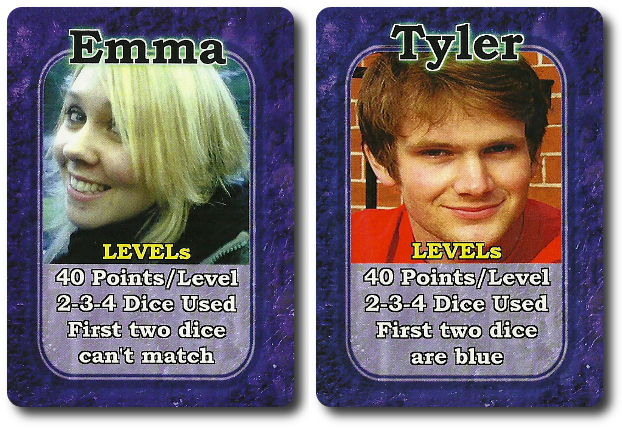
Third, determine the level of difficulty for the game. The game has 3 different levels of difficulty. These are “Easy”, “Normal” and “Hard”. The difficulty of the game determines the level of cooperation necessary by the players and the level of danger of loosing patrons. Go through the Animal card deck and separate the Animal cards by the number of capture dice each requires. These will be “1 (Easy)”, “2 (Medium)”, or “3 (Hard)”. Shuffle these three decks and then randomly build the Animal deck to be used in the game based on the number of Animal cards from each of the three decks. Shuffle this now combined Animal deck and place the remaining Animal cards back in the game box.
Fourth, after shuffling the Animal deck to be used in the game, place it face-down in the middle of the playing area and then draw the four top cards, placing them above, below, left, and right of the Animal card deck, face-up.
Fifth, shuffle the Activity and Event decks and place them face-down next to the Animal deck.
Sixth, set all 18 Patron cards face-up in two 3 x 3 grids to the left and the right of the Animal deck. When you are done, your playing area might look something like the following.
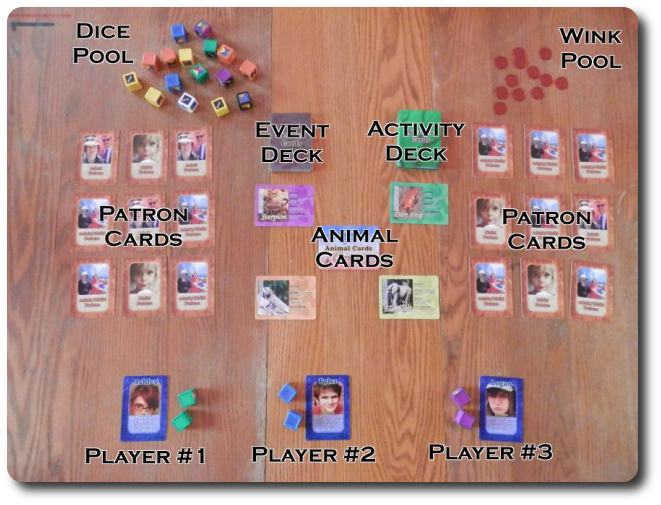
Example of a 3-player game set up
That’s it for game set up. Time to save the zoo!
Zookeeping 101
Save the Zoo is a cooperative game, meaning all the players are working together. Players are not in competition with each other and they will either all win or all lose. The game is played in rounds with each player taking a turn per round. A typical game round is summarized here.
Step 1: Announce Action
The first thing all the players will do is announce to the table, starting with the first player and going clockwise, what they will be doing for their action. As this is a cooperative game, feel free to discuss what actions should be taken and decide as a group what the best way is to save the zoo. Keep in mind that players are working as a team, but no player should ever be forced to take an action or play in any way they don’t think is correct.
The possible actions include:
- Draw an Activity card
- Give items to other players
- Attempt to capture an animal
- Assist in capturing an animal
- Open a gate
- Assist in opening a gate
Note that the first player must ALWAYS either take the action to capture an animal or open a gate.
Step 2: Take Actions
Starting with the first player, the announced actions are taken. Players cannot change their announced action during this step. This is why it’s critical that the players discuss their strategy during step 1. During step 2, it’s go time.
Draw an Activity Card
The player draws the top Activity card from the Activity deck and places if face-up next to their Character card. If the Activity deck is exhausted, shuffle the discarded Activity cards to create a new Activity deck. If there are no Activity cards available in the deck, and there are no discarded Activity cards available, the player cannot take this action.
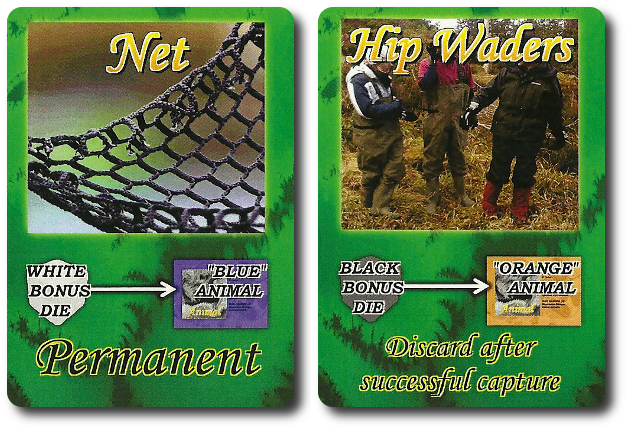
Give Items to Other Players
The player can give up to 2 Activity cards they have next to their Character card to other players. One card each can be given to 2 different players or 2 cards can be given to 1 player.
Capture Animals
Animal cards come in 5 different colors. These are blue (representing birds), purple (representing insects), green (representing amphibians), orange (representing reptiles), and yellow (representing larger animals like the lions, elephants, and bears). Each Character card starts with 2 dice that match one or two different Animal cards. Thematically speaking, this represents the Character’s initial level of knowledge about animals and zookeeping in general.
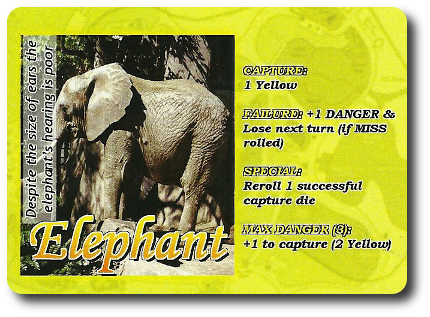
Only Animal cards that are not hidden behind gates and are currently face-up can be captured by the players. If two or more players state they will attempt to capture the same animal, one of the players must become the “primary” who will use all their dice in the capture attempt. All other players are assisting and can only add 1 of their currently available dice to the roll.
On each Animal card is a listed value under the title “Capture”. This lists the number of colors that must be rolled in order for the animal to be successfully captured. When players roll, they look at the top of the dice faces to determine what color it represents. If the dice face shows more than one, it can represent any 1 color that is showing. A “Miss” or any other colored rolled that does not match the “Capture” requirement is ignored.
A successful roll will remove the Animal card and the players are that much closer to victory.
A failed roll will always result in 1 plastic wink being added to the Animal card. Some Animal cards also list additional “Failure” results that are followed after the capture attempt fails. Some Animal cards also have a “Special” and “Max Danger” ability that triggers a new rule that is applied when it’s appropriate to do so. For example, when a “Miss” is rolled during a capture attempt. If there is a negative effect to a player, it always targets and affects the “primary” player.
Half of the die faces (3 out of 6) represent the color value of the die being rolled. There are also 2 “wild” faces that can represent any color shown and 1 “Miss”. The white and black die are an exception to the rule here when it comes to the layout of the die. The white die’s majority of faces provide 1 of any 4 possible colors and 1 “Miss”. The black die’s majority of faces provide 1 of any 2 possible colors and 1 “Miss”.
Open Gates
There are several “Gate” Event cards in the game. Animals behind gates cannot be captured. Gates can be easily opened if the player has the matching colored “Key” Activity card (which can be spent without taking up an action and removes the gate immediately). If they don’t, they can still attempt to open it up by rolling their dice. And just like capturing an Animal card, other players can assist in the effort. Unlike capturing an Animal card, the white and black dice (which are considered “bonus dice”) cannot be part of the roll. The players successfully remove the gate when they roll 2 or more colors that match the “Gate” Event card color. If the players fail, the gate remains with no further penalty to the players other than the sting of knowing a turn has been wasted.
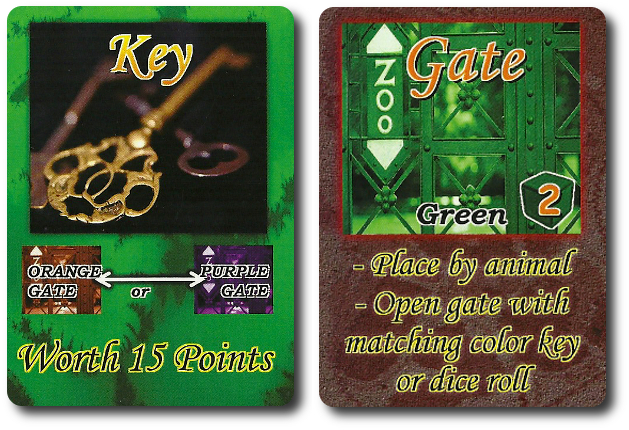
Just because you have a key doesn’t mean it will open a gate!
Only one gate can be placed on an active Animal card at a time.
Once all the players have gone, it’s now the animals’ turn…
Step 2: Animal Actions
During this step of the game, the animals will complete a number of actions in sequential order. They are summarized here.
- Draw and Resolve Event Cards: One player draws a number of Event cards equal to the number of players in the game one at a time and reads them out loud. Note that some Animal cards might require the players to draw more based on their abilities. This is indicated under the “Special” and “Max Danger” text on the Animal card. “Max Danger” abilities only trigger if the Animal card has 3 winks on it.
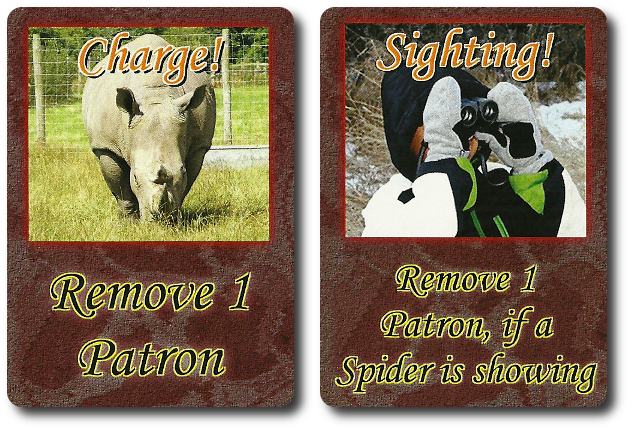
- Wink Resolution: Review each Animal card’s “Special” and “Max Danger” abilities to determine if more plastic winks should be added. “Max Danger” abilities only trigger if the Animal card has 3 winks on it.
- Patron Resolution: Review each Animal card’s “Special” and “Max Danger” abilities to determine if Patron cards are removed. “Max Danger” abilities only triggers if the Animal card has 3 winks on it.
- Animal Reveal: If there are less than 4 active Animal cards in play, draw as many Animal cards as needed to return the total active Animal cards to 4. If there are not enough cards in the Animal deck, draw as many as possible.
If the player’s have not lost or won the game, a new round begins!
LEVEL UP!!!!
It has been said that experience is the best teacher, and chasing after escaped animals while simultaneously trying to keep the zoo patrons happy is a hard way to learn. The players will collect cards that provide them points. If they collect a number of points equal to or higher than the points needed to level up the character, they can immediately turn them in without using an action to level up. The player then gets to collect 1 orange, 1 green, 1 blue, 1 yellow, or 1 purple die that is permanently added to their total number of dice available to roll. Thematically speaking, this shows the zookeeper has learned enough to obtain a serendipitous moment during their “on the job training”.
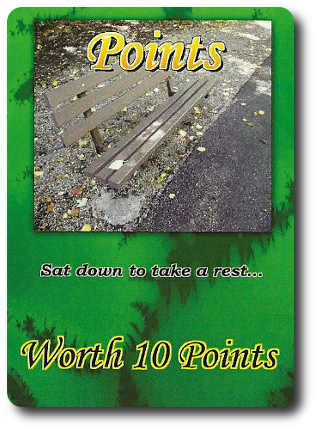
Each character can only go as far as “Level 3” when advancing.
Saying Goodbye to Patrons
Players can lose Patrons several different ways. A forced action from an Event card, a failed capture attempt, or an Animal ability. When a Patron is to be removed, the wordage will either be descriptive that states why type of Patron (for example, “Child”) or simply states any Patron. When a specific keyword is used to describe the Patron to be removed, players look through the Patron cards and remove 1 Patron card from play that matches the keyword. If none are found, no Patrons are lost.
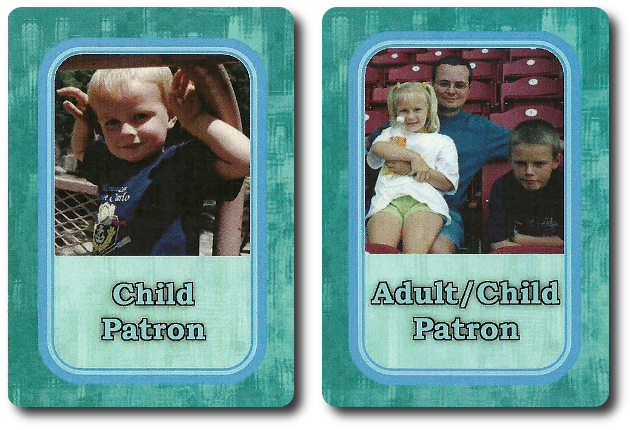
Saving or Losing the Zoo
The players win if they are able to capture all 10 of the Animal cards before the last Patron card is removed from play. If they fail to do so, and the last Patron walks out of the zoo while animals are still on the loose, the zoo will be shutdown forever.
Game Variant
- Going Solo: Save the Zoo can be played as a solitaire game. Set up and game play is the same except that step 1 is ignored and the player can take any single action they like during step 2.
Home Rule
- The rules do not state if the First Player card rotates after a round of play. We decided that the best course of action was to have the First Player card passed to the next player in turn order sequence. This gave everyone a chance to be the first player and made certain that the same player was never forced to take the same actions every turn for the duration of the game. Which sounds really boring.
To learn more about Save the Zoo, visit the game’s web page on the Game Crafter.
Prediction
Once again, my gaming table plays host to another cooperative game. Did you know there was a time when cooperative games were unheard of? True story! Most board and card games always had a definitive single winner or a team of winners. Then cooperative games starting to appear. The first one I remember seeing and playing was Pandemic and it blew my mind. I had never played a game like it before and I loved the idea that we all had to work together to beat the game. Even more impressive was how well the game reacted to what the players were doing. I wouldn’t go so far as to suggest that the bits of cardboard and wood had a level of artificial intelligence, but it was downright creepy at times how the game would backdoor us or move to block what we were doing. The only other time I had seen a game react to a player like that was when it was a video game. It was right then and there that I became a fan of cooperative games and am still a huge fan today.
Save the Zoo will be the first cooperative zoo themed game I have played. I’ve played other zoo-specific themed games, but never like this. And yet, I am not seeing anything in the game rules to suggest that what is being offered will excite the Gamer Geeks. Using dice as a resource, and a fickle resource at that, leaves me a bit cold. I doubt the Gamer Geeks are going to approve Save the Zoo as a result. But the dice do open up the game to some interesting possibilities. For one, it makes the game simpler and it should add a level of excitement and suspense to the game play. Time often slows down as gamers lean in and anxiously await to learn their fate as the dice slwoly stop tumbling.
For the Parent and Child Geeks, I think Save the Zoo will do very well. Where the Gamer Geeks might see all to familiar game play and the unwanted element of luck, Parent and Child Geeks might view it as an exciting opportunity to roll dice, pool resources, and pretend they are running a zoo. While reading is required, it’s not necessary for a player to read the cards to play the game as long as someone reads the cards for them. This should make the game accessible to young Child Geeks and improve its overall level of acceptance at the family gaming table.
Teaching the game is very easy. In fact, players can learn as they play without slowing down the game much, negatively impacting their effectiveness as a player, or reducing their odds of winning. This is because one player can lead the group and describe the choices that need to be made without making the choices for the players. The cards are very descriptive and the most complicated aspect of the game is simply choosing where to focus first. But even then, players have lots of time to change their mind and shift directions. Save the Zoo gives players a lot of runway to taxi on. The level of stress on this game should be almost non-existent for the “Easy” difficulty and only slightly more as the game’s difficulty increases.
After teaching the game to my two oldest Child Geeks, I asked them their thoughts on the game so far.
“A cooperative game were we use dice as a resource? I don’t think I’ll have any problem playing and enjoying this game.” ~ Liam (age 8)
“No questions, Daddy. I match the dice to the animal and roll. We’ll save the zoo in no time!” ~ Nyhus (age 5)
Looks like both of my little geeks understand the game fairly well and are eager to capture those animals! Let’s play Save the Zoo and see if we can rescue the zoo patrons or unwittingly feed the tigers.
Final Word
The Child Geeks had a great time playing the game and helping make decisions as a team. They demonstrated a strong grasp of the game’s play and the importance of working together to capture animals. Even the youngest Child Geeks we played the game with were actively participating at the gaming table and were either lending a hand or leading the charge. “Easy” to “Moderate” was found to be the best levels of difficulty, with “Easy” being just a bit too simple for the older Child Geeks. The only complaint the Child Geeks had concerned the lack of specific animals. “Where are the sharks, Daddy? We’ve been too a zoo with sharks.” Despite not being happy that their favorite animals were missing from the game or some specific animals in the game not showing up often enough, all the Child Geeks found Save the Zoo to be a fun family adventure at their gaming table.
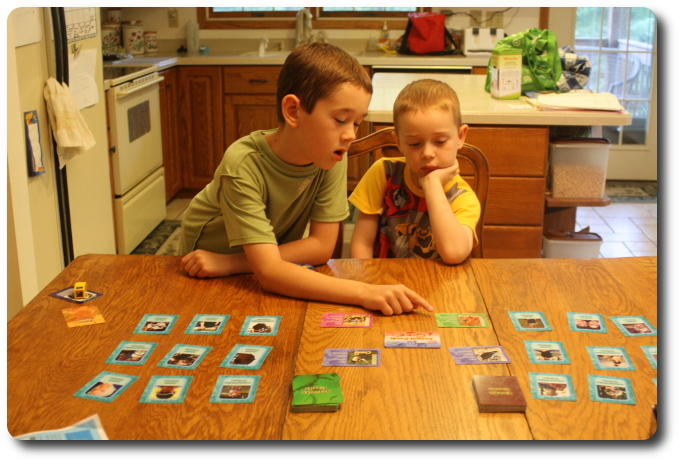
My two oldest child geeks discuss their plan of attack before we attempt to save the zoo
The Parent Geeks found Save the Zoo to be too simple when played with their peers. Decisions were easy and the game at its hardest level of difficulty only meant more cooperation and communication rather than more fun. Clearly, at a peer level, Save the Zoo did little to enthrall the Parent Geeks. According to one Parent Geek, “Not a bad game. It’s just not an interesting one.” When Save the Zoo was played with the Parent Geeks and the Child Geeks, the Parent Geeks did a 180 degree turn. They found Save the Zoo to be an entertaining game for the family, especially when their Child Geeks started to play more actively at the table instead of passively doing what their parents suggested. According to the same Parent Geek who didn’t care for the game with her peers, “Oh, this is a lot of fun with the family! I never knew running a zoo could be so entertaining!” Parent Geeks, as I have often times observed, tend to gravitate towards those games that can be played with their children even if they can’t be played with their peers. If I were to ask for the Parent Geeks’ endorsement when they only played Save the Zoo with their fellow adults, it would have received mixed approval at best. After a single game with the Child Geeks, all the Parent Geeks were signing its praise.
The Gamer Geeks are much more pragmatic when it comes to their level of endorsement. They either like it or don’t and seldom care if it’s a “good game” for their kids or not. Oh, they love their kids (the Gamer Geeks I play with are some of the best parents I have ever had the pleasure of knowing), but this isn’t about their young protegé. This is about games, dammit! And they know their games. Or, at the least, think they do. Gamer Geeks have, if nothing else, strong opinions based on personal feelings and years of game playing experience. And after playing Save the Zoo they found it to be a game not worth playing again. According to one Gamer Geek, “There is nothing of value here when it comes to the game. I roll dice or give a card or take a card. I didn’t feel like I was saving a zoo.” Another Gamer Geek stated, “I can see why you said this was a game that scored high for the family, but at this gamer’s table, I’m enjoying my beer more than the game.” And finally, from one last Gamer Geek, “Hey, look. I can’t design games, but I know what I like. I don’t like this game, but I know I couldn’t design one better.” The Gamer Geeks voted to not give Save the Zoo their endorsement and weren’t about to lose a minute of sleep over the zoo closing for good.
As a Parent Geek, I really enjoyed my time with Save the Zoo. I found it to be a fun game to play with my kids, as well as with mixed age and skill groups. I could play the game with non-gamers just as well as new gamers. Everything about the game works well, is easy to teach, and even easier to learn. As a Gamer Geek, the game doesn’t interest me. I never felt like I couldn’t beat the game even at the hardest level of difficulty and our group’s actions were all limited and very straight forward.
Save the Zoo is a light cooperative game that facilitates fun, communication, and teamwork. It would make for a great introduction to cooperative games, as the theme is easy to grasp and the game play is very straightforward. At a family and parent level, that is exactly what I want. At a Gamer Geek level, I want more out of my games. More teeth, more bite, and more visceral game play. Save the Zoo never provided a gaming experience to that level. In the end, I will be keeping Save the Zoo because my little geeks enjoy playing it and I enjoy playing it with them. If I didn’t have little geeks, I would pass the game on.
This game was given to Father Geek as a review copy. Father Geek was not paid, bribed, wined, dined, or threatened in vain hopes of influencing this review. Such is the statuesque and legendary integrity of Father Geek.



